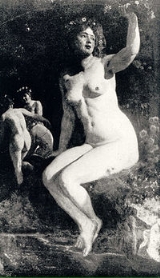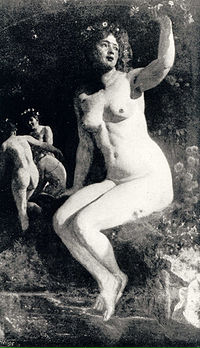
Kupala
Encyclopedia

Feast
Ivan Kupala DayIvan Kupala Day
Kupala Day is celebrated in Poland, Russia, Belarus and Ukraine currently on the night of 6/7 July in the Gregorian or New Style calendar, which is 23/24 June in the Julian or Old Style calendar still used by many Orthodox Churches. Calendar-wise, it is opposite to the winter solstice holiday...
(John the bather day) is the feast day of John the Baptist
John the Baptist
John the Baptist was an itinerant preacher and a major religious figure mentioned in the Canonical gospels. He is described in the Gospel of Luke as a relative of Jesus, who led a movement of baptism at the Jordan River...
in some Central and East European countries, held near the summer solstice
Summer solstice
The summer solstice occurs exactly when the axial tilt of a planet's semi-axis in a given hemisphere is most inclined towards the star that it orbits. Earth's maximum axial tilt to our star, the Sun, during a solstice is 23° 26'. Though the summer solstice is an instant in time, the term is also...
. It is equivalent of Valentine's Day.
For some neo-pagans, Kupała, also known as Sobótka, is the festival celebrated on the Summer solstice
Solstice
A solstice is an astronomical event that happens twice each year when the Sun's apparent position in the sky, as viewed from Earth, reaches its northernmost or southernmost extremes...
in June. They believe that it was a sacred holy day honoring the two most important elements: Fire and Water. The tradition is to burn fires at the end of the day and bathe in open waters at sunset, singing and dancing around 'pal' till midnight. At midnight, under the pretext of searching for "Fern flower
Fern flower
The fern flower Chervona Ruta is a magic flower in Slavic mythology and in Baltic mythology .-Slavic tradition :According to the myth, this flower blooms for a very short time on the eve of the Summer solstice The flower brings fortune to the person who finds it...
|the flower of the Fern," unmarried men and women run into the forest. Ladies with a crown of flowers on their head (Polish: wianek), a symbol of their unmarried state, go first, singing. Next they are followed by single men. If you find the "flower of the Fern" the wishes of life may be fulfilled. However, nobody found it so far, but they lived happily together. The lucky man would return with a flower ring on his head, with the now engaged lady.
Jan Kochanowski, a Polish poet who happened to participate in the festivities, gives a description of the night in his Pieśń o Sobótce, Jan Kochanowski
Jan Kochanowski
Jan Kochanowski was a Polish Renaissance poet who established poetic patterns that would become integral to Polish literary language.He is commonly regarded as the greatest Polish poet before Adam Mickiewicz, and the greatest Slavic poet, prior to the 19th century.-Life:Kochanowski was born at...
, Quote: :Gdy słońce Raka zagrzewa, :A słowik więcej nie śpiewa, :Sobótkę, jako czas niesie, :Zapalono w Czarnym Lesie.
The younger girls all, dressed in white, float her flowers (with candles) on the rivers, the sign, somebody may discover and come next year to her to exchange the dray flowers for flourishing wianek of her.
The pal en:pole all dances around is a symbol of tree of life and kupala older ką pala or now "ku palu" mean to pole, in the direction of pole. The taking bath in water is kąpiel . The way of singing without accompaniment is a kapella. The tradition of Kupala may have old IE origin. Kochanowski relation of the folk song highlight it few times:
- Tak to matki nam podały, | Our mothers gave it to us
- Samy także z drugich miały | They also from their mothers inherited it
- A teraz ten wieczór sławny
- Święćmy jako zwyczaj dawny
In other verses is described the pra old character of this fest. And the tradition especially watering the flowers rings continue today the youngest keep best the tradition.
Deity
In his book Deutsche MythologieDeutsche Mythologie
Deutsche Mythologie is a seminal treatise on Germanic mythology by Jacob Grimm. First published in Germany in 1835, the work is an exhaustive treatment of the subject, tracing the mythology and beliefs of the Ancient Germanic peoples from their earliest attestations to their survivals in modern...
(1835), Jacob Grimm
Jacob Grimm
Jacob Ludwig Carl Grimm was a German philologist, jurist and mythologist. He is best known as the discoverer of Grimm's Law, the author of the monumental Deutsches Wörterbuch, the author of Deutsche Mythologie and, more popularly, as one of the Brothers Grimm, as the editor of Grimm's Fairy...
noted that Russians used the word "kupala" to describe the bonfires they lit at the summer solstice
Summer solstice
The summer solstice occurs exactly when the axial tilt of a planet's semi-axis in a given hemisphere is most inclined towards the star that it orbits. Earth's maximum axial tilt to our star, the Sun, during a solstice is 23° 26'. Though the summer solstice is an instant in time, the term is also...
, and recorded that some people explained the word as the name Kupulo, a harvest god.
In Slavonic neo-paganism, Kupała is the goddess
Goddess
A goddess is a female deity. In some cultures goddesses are associated with Earth, motherhood, love, and the household. In other cultures, goddesses also rule over war, death, and destruction as well as healing....
of herb
Herb
Except in botanical usage, an herb is "any plant with leaves, seeds, or flowers used for flavoring, food, medicine, or perfume" or "a part of such a plant as used in cooking"...
s, sorcery
Magic (paranormal)
Magic is the claimed art of manipulating aspects of reality either by supernatural means or through knowledge of occult laws unknown to science. It is in contrast to science, in that science does not accept anything not subject to either direct or indirect observation, and subject to logical...
, sex
Sex
In biology, sex is a process of combining and mixing genetic traits, often resulting in the specialization of organisms into a male or female variety . Sexual reproduction involves combining specialized cells to form offspring that inherit traits from both parents...
, and midsummer
Midsummer
Midsummer may simply refer to the period of time centered upon the summer solstice, but more often refers to specific European celebrations that accompany the actual solstice, or that take place on a day between June 21 and June 24, and the preceding evening. The exact dates vary between different...
. She is also the Water Mother, associated with tree
Tree
A tree is a perennial woody plant. It is most often defined as a woody plant that has many secondary branches supported clear of the ground on a single main stem or trunk with clear apical dominance. A minimum height specification at maturity is cited by some authors, varying from 3 m to...
s, herbs, and flower
Flower
A flower, sometimes known as a bloom or blossom, is the reproductive structure found in flowering plants . The biological function of a flower is to effect reproduction, usually by providing a mechanism for the union of sperm with eggs...
s. Her twin
Twin
A twin is one of two offspring produced in the same pregnancy. Twins can either be monozygotic , meaning that they develop from one zygote that splits and forms two embryos, or dizygotic because they develop from two separate eggs that are fertilized by two separate sperm.In contrast, a fetus...
sister is Kostroma
Kostroma (deity)
Kostroma is an East Slavic fertility goddess. The rites of Semik were devoted to her. During this festival a disguised girl or a straw figure portrayed Kostroma. First, a scarecrow was honored and revered. Then, participants of the rite mourned the death of Kostroma, and burned or tore the scarecrow...
. Her celebration falls upon the Summer solstice
Solstice
A solstice is an astronomical event that happens twice each year when the Sun's apparent position in the sky, as viewed from Earth, reaches its northernmost or southernmost extremes...
in June, which is a sacred holy day honoring the two most important elements of Fire and Water.

